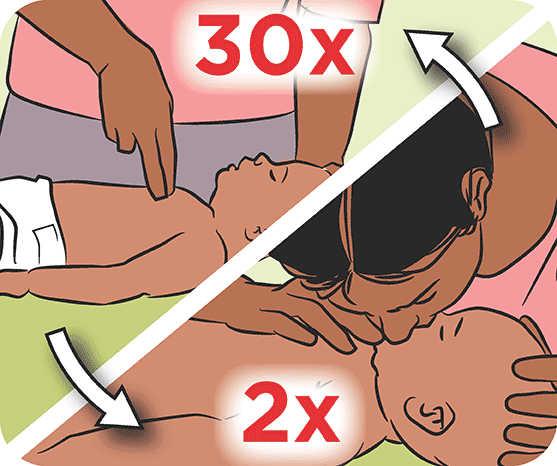Congratulations on your new baby!

Whether your baby was in the NICU or not, bringing home a new baby is a major life transition that requires a lot of support.
Here are some tips to help ease the transition:
- Accept all help that is offered
- Ask friends and family to help with errands, meal preparation, housework, and care of other children
- Tune into your baby’s cues (hunger, fatigue)
- Seek breastfeeding support if you need it. It does not always come naturally. You can call your OBGYN or pediatrician to ask for a consultation with a lactation specialist.
- Schedule medical appointments in advance and make them in the late morning if possible.
- Try to get outside if the weather allows
- Always practice safe sleep
- Read to your baby every day
- Start tummy time right away- just five minutes a day makes a big difference!
Feeding your baby
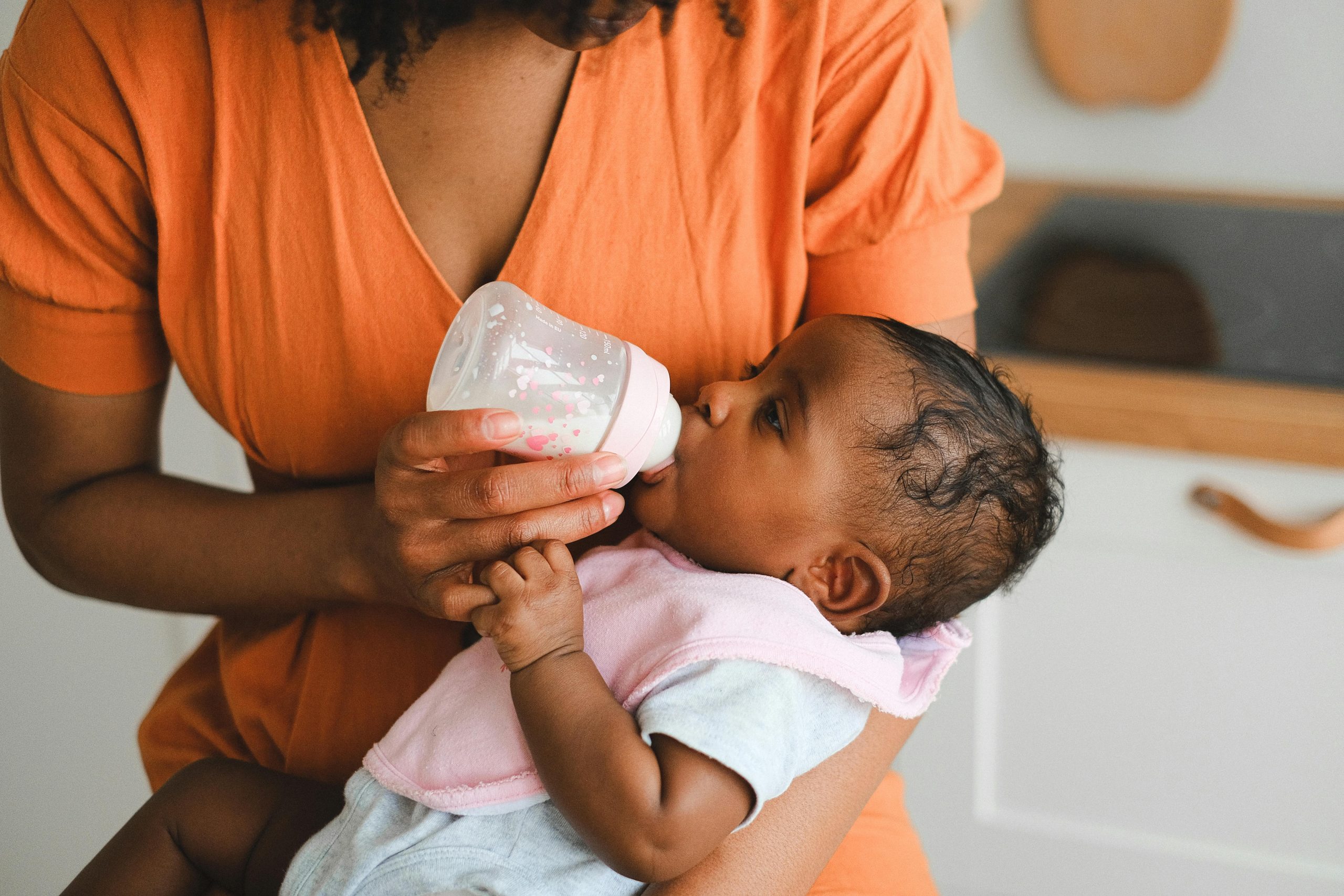 Feeding your baby is often the most exhausting part of being a new parent, but hopefully these tips will help make it a little more efficient.
Feeding your baby is often the most exhausting part of being a new parent, but hopefully these tips will help make it a little more efficient.
Learn signs that your baby is hungry or full when they are breastfeeding or bottle feeding.
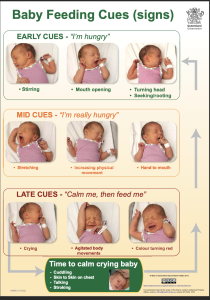
Early cues of hunger:
- Turning head (rooting reflex)
- Stirring
- Opening and closing their mouth, puckering lips,
sticking tongue out - Putting hand to their mouth, sucking on hands, fingers, clothing, etc.
Mid cues:
- Alertness
- Stretching
- Positioning towards the chest of whoever is holding them
- Squirming
- Fussing noises
Late feeding cues: (If you get to this point, baby will likely need some calming before feeding *see our calming guide below):
- Clenched fists
- Moving head from side to side
- Agitated and crying
Common Breastfeeding Positions
Learn more about the five most common breastfeeding positions to get you started.
Navigating newborn feeding schedules can be challenging for new parents, but understanding basic guidelines makes it easier.

Example Newborn Feeding Schedule:
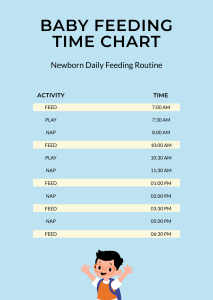
Stem Starts Now Breastfeeding Pump Log
How Do I Know If My Newborn is Eating Enough?
- Wet diapers: By the fourth day of life, newborn babies should have 6-8 wet diapers per day.
- The Art of Baby Massage:
- A gentle way to connect with your baby and help relieve gas, colic, and constipation.
- The Art of Baby Massage:
- Bowel movements: Stool frequency can vary, but your baby should have at least a few bowel movements per week. The stool color can also provide clues to how well they’re tolerating their feedings and overall health.
- Stool consistency: After the initial dark, sticky stools, a baby should have soft, yellow, seedy stools.
- Feeding cues: Baby actively rooting, sucking, opening mouth when hungry, and appearing satisfied after feeding.
- Steady Weight gain: Your pediatrician will help you track your baby’s weight gain to ensure they are growing properly.
- Alertness: Baby looks alert and active when awake.
- Frequent feedings: Nursing 8-12 times per day is typical for newborns.
When to consult a doctor:
- If your baby is not gaining weight adequately
- If your baby has significantly fewer wet diapers than expected
- If your baby seems excessively fussy or lethargic
- If you are concerned about your baby’s feeding behavior
Lactation Consultation
A lactation consultant is a health professional who specializes in breastfeeding and in offering breast milk to infants. You might need this support during the first few weeks of your baby’s life. This is when your baby is learning how to nurse, and both of you may need more support.
- Challenges like nipple pain or low milk supply make some women stop breastfeeding. Lactation consultants are trained to work with infants and their parents to address any feeding challenges.
-
- What do lactation consultants do?
-
-
- Find comfortable breastfeeding positions for you and your baby
- Help your baby latch
- Recognize and learn more about your baby’s hunger cues
- Develop a feeding schedule
- Increase, decrease or maintain your milk supply, depending on your individual needs
- Check if your baby is gaining weight
- Pump or express milk by hand or with a breast pump
- Wean your baby
- Do kangaroo care (skin-to-skin contact)
- Prepare for return to work
-
- Breastfeeding is a different journey for everyone. Transitioning between bottle and breastfeed.
-
-
- Begin the transition by feeding the baby with a small amount of breast milk before he would typically get hungry. By doing so, the baby will remain calm.
- If you’ve been patient and have tried the same bottle multiple times with no positive results, consider changing the nipple or actual bottle. Be sure to try each new device for a few days before you move on to the next one.
- Once you’ve found a bottle that works and the baby responds positively, increase the amount of milk given until you reach a full feeding.
-
-
References:
Cleveland Clinic. (2025). Lactation consultant. https://my.clevelandclinic.org/health/articles/22106-lactation-consultant
Enfamil. (n.d.-a). Newborn Feeding Schedule for Formula. https://www.enfamil.com/articles/newborn-formula-feeding-schedule/
Enfamil. (n.d.-b). The essential guide to baby stool types and color. https://www.enfamil.com/articles/parents-baby-poop-guide/
Harris, N. (2024). An age-by-age feeding chart for newborns and babies. Parents. https://www.parents.com/baby/feeding/baby-feeding-chart-how-much-and-when-to-feed-infants-the-first-year/#citation-1
Jain, S., & Bunik, M. (2024, March 22). How often and how much should your Baby Eat?. Healthy Children. https://www.healthychildren.org/English/ages-stages/baby/feeding-nutrition/Pages/how-often-and-how-much-should-your-baby-eat.aspx
Murray, D. (2024). 5 common breastfeeding positions to try. Parents. https://www.parents.com/the-top-5-breastfeeding-positions-8649820
The Breastfeeding Center. (2022).Infant feeding cues and their importance. https://www.breastfeedingcenter.org/blog/2022/1/18/infant-feeding-cues-and-their-importance
UPMC Children’s Community Pediatrics. (n.d.). Breast to bottle. https://www.childrenspeds.com/health-resources/infant-care-and-maternal-health/breast-to-bottle
What is safe sleep?
 Safe sleep means putting your baby to sleep in ways that can help protect them from dangers, like choking and suffocation.
Safe sleep means putting your baby to sleep in ways that can help protect them from dangers, like choking and suffocation.
The ABC’s of Safe Sleep
Alone– Babies should always be on their own sleep surface. Bed sharing is a risk factor for Sudden Unexpected Infant Death (SUID) and other sleep related deaths.
- SUID, which includes Sudden Infant Death Syndrome (SIDS), is the leading cause of injury death in infancy.
Back – Babies should be on their back for every sleep.
Crib – Use a crib, bassinet or portable play yard with a firm, flat mattress and a fitted sheet that is empty. This means no bumper pads, pillows, blankets, stuffed animals, toys, or supplies, like diapers and diaper wipes.
- *** Additionally- Breastfeed if possible and avoid having baby in and around secondhand smoke.
Infant Safe Sleep Resource
Video: https://www.youtube.com/watch?v=T8QNODDhve8
Link to Stem Starts Now Safe Sleep
AAP Safe Sleep Practices
https://www.aap.org/en/patient-care/safe-sleep/provider-and-patient-conversations-for-safe-sleep/
Nighttime Routine
Expert tip: Did you know that a calm and stress-free bedtime routine is
also important for you as parents? Setting up a peaceful bedtime routine
with your baby will set you up for a peaceful night of self-care, relaxation,
or connecting with your partner.
Link to Bedtime Routine Checklist
Link to Stem Starts Now Bedtime Routine
Newborn Bedtime Routine
- Create a Calm Environment:
- Dim the lights and ensure the room is quiet.
- Play soft, soothing music or white noise if needed.
- Warm Bath (Optional):
- Give your baby a warm bath if it’s part of your routine. Make sure the water is the right temperature.
- Gently wash them with a soft washcloth, keeping things relaxed and calm.
- Baby Massage:
- After the bath (or if you skip it), use a baby-safe lotion or oil.
- Gently massage your baby’s arms, legs, back, and tummy using soft, circular motions.
- Talk to your baby softly or sing a lullaby while you massage them. This helps create a relaxing bond.
- Diaper Change & Pajamas:
- Change your baby into a fresh diaper and soft, comfy pajamas.
- Ensure your baby is comfortable and cozy.
- Reading a Book:
- Choose a soft, simple book with gentle pictures or textures.
- Hold your baby close and read the book slowly, speaking softly.
- You can even point at pictures and describe them in a calm voice to make the experience interactive.
- Feeding (if necessary):
- If your baby needs a final feed before sleep, gently offer them the breast or bottle.
- Make this a peaceful and slow-paced moment.
- Cuddling and Rocking:
- Hold your baby close and give them a cuddle while you gently rock them or sway.
- This helps your baby feel safe and secure as they drift off.
- Place Baby in Crib:
- Gently place your baby in their crib and on their back, ensuring they are safe and secure.
- If they’re not fully asleep yet, give them a little time to settle themselves.
- Exit the room quietly, leaving your baby in a calm environment, ready to fall asleep.
References:
American Academy of Pediatrics. (2024). Provider and patient conversations for safe sleep. https://www.aap.org/en/patient-care/safe-sleep/provider-and-patient-conversations-for-safe-sleep/
Eunice Kennedy Shriver National Institute of Child Health and Human Development. (n.d.). Ways to reduce baby’s risk. U.S. Department of Health and Human Services. https://safetosleep.nichd.nih.gov/reduce-risk/reduce
March of Dimes. (2019). Safe sleep for your baby. https://www.marchofdimes.org/find-support/topics/parenthood/safe-sleep-your-baby
Missouri Children’s Trust Fund. (2019). The ABCs of infant safe sleep [Video]. YouTube. https://www.youtube.com/watch?v=T8QNODDhve8
Nationwide Children’s Hospital. (2020). Safe sleep practices for babies. https://www.nationwidechildrens.org/family-resources-education/health-wellness-and-safety-resources/helping-hands/safe-sleep-practices-for-babies
Bathing/ Hygiene
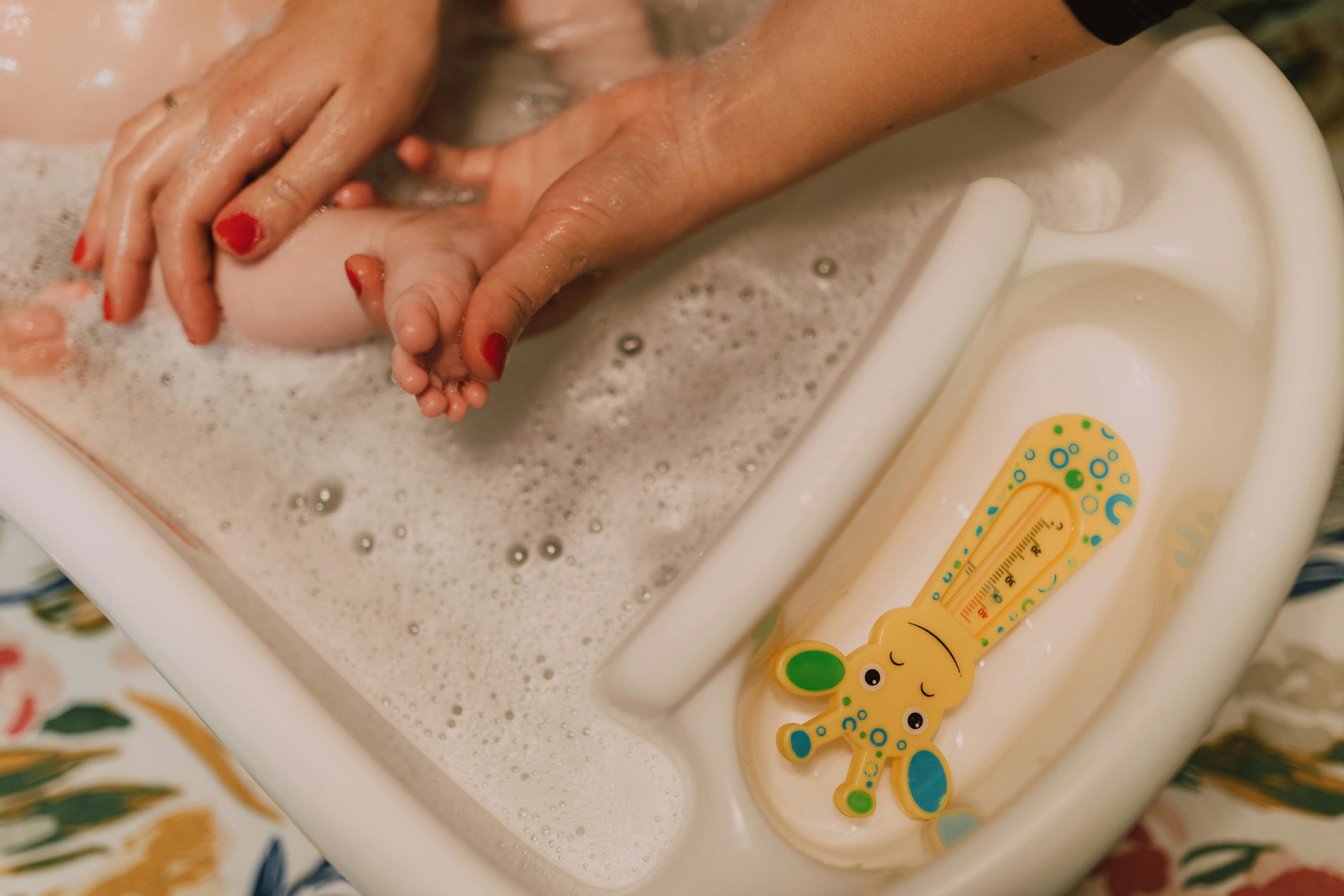
Bathing/hygiene is important for babies, it means maintaining cleanliness and comfort, preventing infections, and promoting healthy skin.
Swaddle Bathing:
A swaddle bath involves bathing a newborn while they are wrapped in a loose blanket and is likely how your baby was bathed in the NICU. The baby and the blanket are immersed in a tub of water, while each limb is carefully unswaddled, washed, rinsed, and swaddled again. Swaddle bathing is research-based, best practice for neonatal bathing.
| ‘I like this’ cues: | ‘I need more support’ cues: |
|
|
How To Do A Swaddled Bath
Video: https://www.youtube.com/watch?v=DJ3xFgNAeN0
Bathing Guide:
- Sponge Baths (Newborn to 1 Month):
- Why: Until your baby’s umbilical cord stump falls off (usually around 1-2 weeks old), you should avoid submerging the baby in water. A sponge bath will keep the area dry and reduce the risk of infection.
- When to Stop: Once the umbilical cord stump falls off and the area heals (usually by 1 month), you can transition to full baths.
- Full Baths (1 Month and Older):
-
- Why: Once your baby’s umbilical cord stump has fallen off and the area has healed, it’s safe to give your baby a full bath. Your baby can now safely sit in the water.
- When to Start: This usually happens around the time your baby is 1 month old.
-
Bath Time Tips:
- Frequency: A swaddle immersion bath for your newborn can be a relaxing and bonding experience. However, newborns do not require frequent bathing, once to three times a week is sufficient.
- Set-up: Gather all your supplies near your bath area ahead of time, using baby bath products.
- Process: Begin with a clean cloth and wash baby’s face first, body second and diaper area last. Wipe from the baby’s eyes and mouth into the creases as you go behind his ears, around his neck, into his underarms, between his fingers and toes, and in his diaper area.
- Stay Close: Never leave your baby unattended during bath time, even for a second. Babies and young children can drown in just 1 to 2 inches of water.
- Keep It Short: A bath should only last about 5-10 minutes. Babies can get cold quickly, so keep it brief.
- Watch the Water Temperature: Always test the water temperature with your wrist or elbow before placing your baby in the tub. Swirl water so there are no “hot spots.” Bathwater should be between 98.6 degrees F and 100 degrees F (37 degrees C to 38 degrees C). *Consider getting a thermometer to check the water temperature to eliminate guessing.
- Use a Soft Touch: Baby skin is very sensitive, so use gentle motions when washing your baby. Always support baby’s head and neck during bathing.
- Make Bath Time Fun: Sing or talk to your baby to make bath time enjoyable and soothing.
Umbilical Cord Care: Link to Stem Start Now Umbilical Cord Care
- Always wash your hands before touching baby’s cord stump.
- Fold the top of baby’s diaper down and away from the cord.
- Keep the cord area clean and dry.
- Wipe the cord with warm water and a soft cloth if it gets soiled with baby’s waste.
- Avoid using rubbing alcohol or creams on the cord or covering it with a bandage.
Cradle Cap Care: Link to Stem Starts Now Cradle Cap Care
- Wash baby’s scalp daily with a mild baby shampoo.
- Gently loosen the scales with a soft baby brush or infant comb while the shampoo is on baby’s head. Avoid putting pressure on the soft spot—known as the fontanel—in his head.
- For stubborn cradle cap, apply an infant-safe lotion or oil directly to the scales for at least an hour prior to washing to help gently loosen the scales.
- If cradle cap persists, talk to your baby’s health care provider.
References:
Blocker, K. (2017). Introducing a new bathing technique for newborns. UCHealth. https://www.uchealth.org/today/introducing-new-bathing-technique-newborns/
Kuller, J., & Lund, C. (2024). Newborn skin care advice on bathing and diapering. USCF Benioff Children’s Hospital. https://www.ucsfbenioffchildrens.org/-/media/project/ucsf/ucsf-bch/pdf/newborn-skin-care.pdf
National Health Service. (n.d.). Swaddled bathing. Neonatal Networks Southeast. https://neonatalnetworkssoutheast.nhs.uk/wp-content/uploads/2023/06/Swaddled-bathing.pdf
UCSF Benioff Children’s Hospital Oakland. (2017). How to do a swaddled bath [Video]. YouTube. https://www.youtube.com/watch?v=DJ3xFgNAeN0
Bonding and keeping baby safe
 Did you know babies can become stressed out? Their mental health is very important. Having a secure attachment with a loving caregiver is essential for your baby to feel safe and cared for. You can form this attachment by bonding with your baby through talking, reading, singing, feeding, and providing baby massage. It is also very important to meet baby’s needs immediately. When babies cry, pick them up. You cannot spoil a baby, you are simply teaching them that their needs will be met.
Did you know babies can become stressed out? Their mental health is very important. Having a secure attachment with a loving caregiver is essential for your baby to feel safe and cared for. You can form this attachment by bonding with your baby through talking, reading, singing, feeding, and providing baby massage. It is also very important to meet baby’s needs immediately. When babies cry, pick them up. You cannot spoil a baby, you are simply teaching them that their needs will be met.
Signs of Stress in Baby
- Changes in skin color (baby may become pale, especially the nose, flushed, or blue)
- Changes in vital signs including heart rate, respiratory rate, oxygen saturation
- Yawning, sneezing, gagging, hiccups
- Decreased muscle tone or limpness
- Frantic or flailing movements, arms and/or legs extended and locked
- Finger splaying (the STOP sign)
- Grimacing, looking panicked
- Glassy eyes, “tuning out”, looking away, averting gaze
- Irritable and difficult to console
The 5 S’s to soothe and comfort baby
- Developed to help soothe crying babies and help them sleep better.
- Help babies feel comfortable by copying the safe and cozy feeling of the womb. Helpful during the 4th trimester, the first three months after birth, during postpartum, or if the baby has colic.
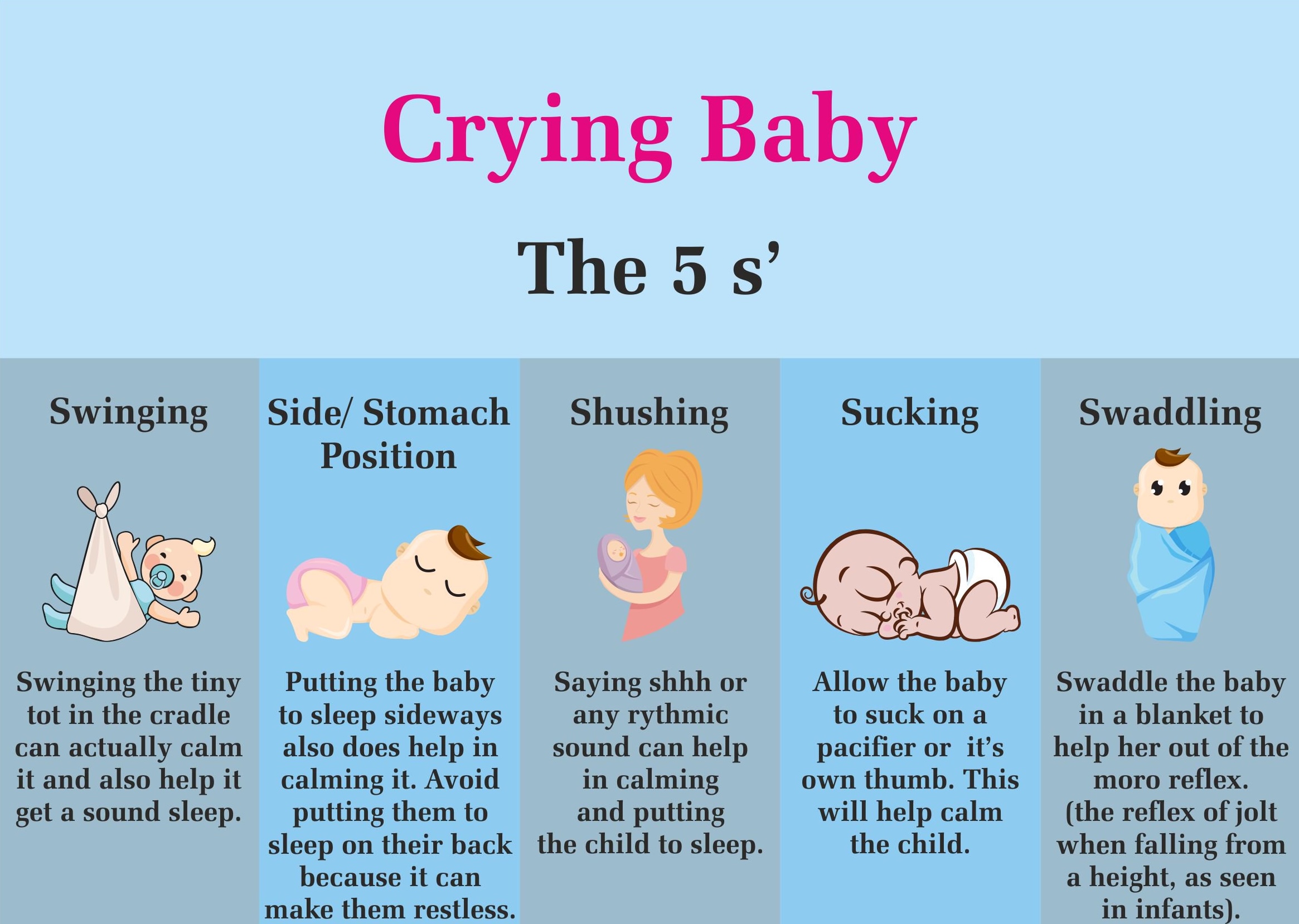
-
- Swaddling: Stem Starts Now Swaddling Resource
- Swaddling your baby means wrapping a baby snugly in a blanket to mimic the secure feeling of the womb. This helps calm babies by preventing their startle reflex from waking them up. Swaddling brings babies to midline helping them to feel secure and promote longer, more restful sleep.
- Swaddling: Stem Starts Now Swaddling Resource

-
- Side or stomach position
-
- Holding a baby on their side or stomach to help them feel calm and less fussy. To use this technique, hold the baby on their side or stomach, supporting their head and neck.
-
- Shushing
- Making a “shhh” sound near the baby’s ear mimics the sounds they heard in the womb. This technique can be very soothing for infants as it helps to block out other noises and create a calming environment.
- Swinging
- Using slow, gentle, rhythmic motion can soothe a baby and help them feel secure and relaxed. Techniques include rocking them in your arms or while babywearing, using a baby swing or gently bouncing them on your knee. This mimics the movement babies felt in the womb. Swinging can be a powerful tool for calming a fussy baby and promoting better sleep.
- Sucking
- Sucking is a comfort tool for babies. Using a pacifier, bottle or breastfeeding can help to soothe and calm a baby. Sucking helps to release endorphins, which are hormones your body releases to relieve pain or stress. And, once a baby’s stress is less, it’s easier for them to relax.
- Side or stomach position
Home/Community Safety
- Baby cardiopulmonary resuscitation (CPR) *It is recommended that all parents of babies who were in the NICU know how to administer CPR to a baby.
- Babies explore their environment by putting anything and everything into their mouths.
- NEVER leave small objects in your baby’s reach, even for a moment.
- NEVER put your baby on anything that is soft enough to cover the face and block air to the nose and mouth.
- NEVER feed your baby hard pieces of food, cut all the foods you feed your baby into thin pieces to prevent choking. Be prepared if your baby needs CPR!
Video: https://www.youtube.com/watch?v=n65HW1iJUuY
General Tips:
- Never shake your baby.
- Never smoke or let anyone smoke around your baby.
- Smoke and carbon monoxide detectors should be installed in your home and checked each month to make sure they’re working correctly.
- Always have one hand on your baby. Never leave them alone:
-
- In a vehicle.
- When giving them a bath.
- In a shopping cart.
- With pets or other animals.
- On a raised surface like a changing table, counter, or chair.
- Anchor furniture to reduce the risk of tip-overs and help prevent serious injury and damage.
- Put safety locks on all cabinets that contain cleaning products, medicine, or any other hazards.
- Put safety covers on electric outlets that are not being used.
- Put baby gates at the top and bottom of any stairs
- If a window is open, do not put furniture like low tables, couches, chairs, or baby gates in front of the window. Your child could climb up on these and fall.
- When your baby starts to crawl or walk, do not let them keep anything in their mouth while moving as this is a choking hazard.
References
American Red Cross. (n.d.). Child and baby CPR. https://www.redcross.org/take-a-class/cpr/performing-cpr/child-baby-cpr?srsltid=AfmBOopErrlXk0LidVf0V8EE8DRS2bLW7uD90TyGN6eBhPetpYsrXKr6
Centers for Disease Control and Prevention. (n.d.). Infants & toddlers: Safety in the home & community. https://www.cdc.gov/parents/infants/safety.html
Cincinnati Children’s. (2013). CPR for infants (Newborn to 1 year). [Video]. YouTube. https://www.youtube.com/watch?v=n65HW1iJUuY
Healthy Children. (2017). Safety for your child: Birth to 6 months. American Academy of
Pediatrics. https://www.healthychildren.org/English/ages-stages/baby/Pages/Safety-for-Your-Child-Birth-to-6-Months.aspx
Nationwide Children’s. (n.d.). Home safety for infants and toddlers. https://www.nationwidechildrens.org/family-resources-education/health-wellness-and-safety-resources/helping-hands/home-safety-for-infants-and-toddlers
RWJBarnabas Health. (n.d.). Recognizing and responding to your baby’s stress signals. https://www.rwjbh.org/documents/saint%20barnabas%20medical%20center/SmallBabyStress.pdf
The Mother Baby Center. (2024). The 5 S’s to soothe and comfort baby. https://www.themotherbabycenter.org/blog/2024/09/5-ss-baby/#:~:text=Karp’s%20book%2C%20“The%20Happiest%20Baby,%2C%20shushing%2C%20swinging%20and%20sucking
Education/ Milestone
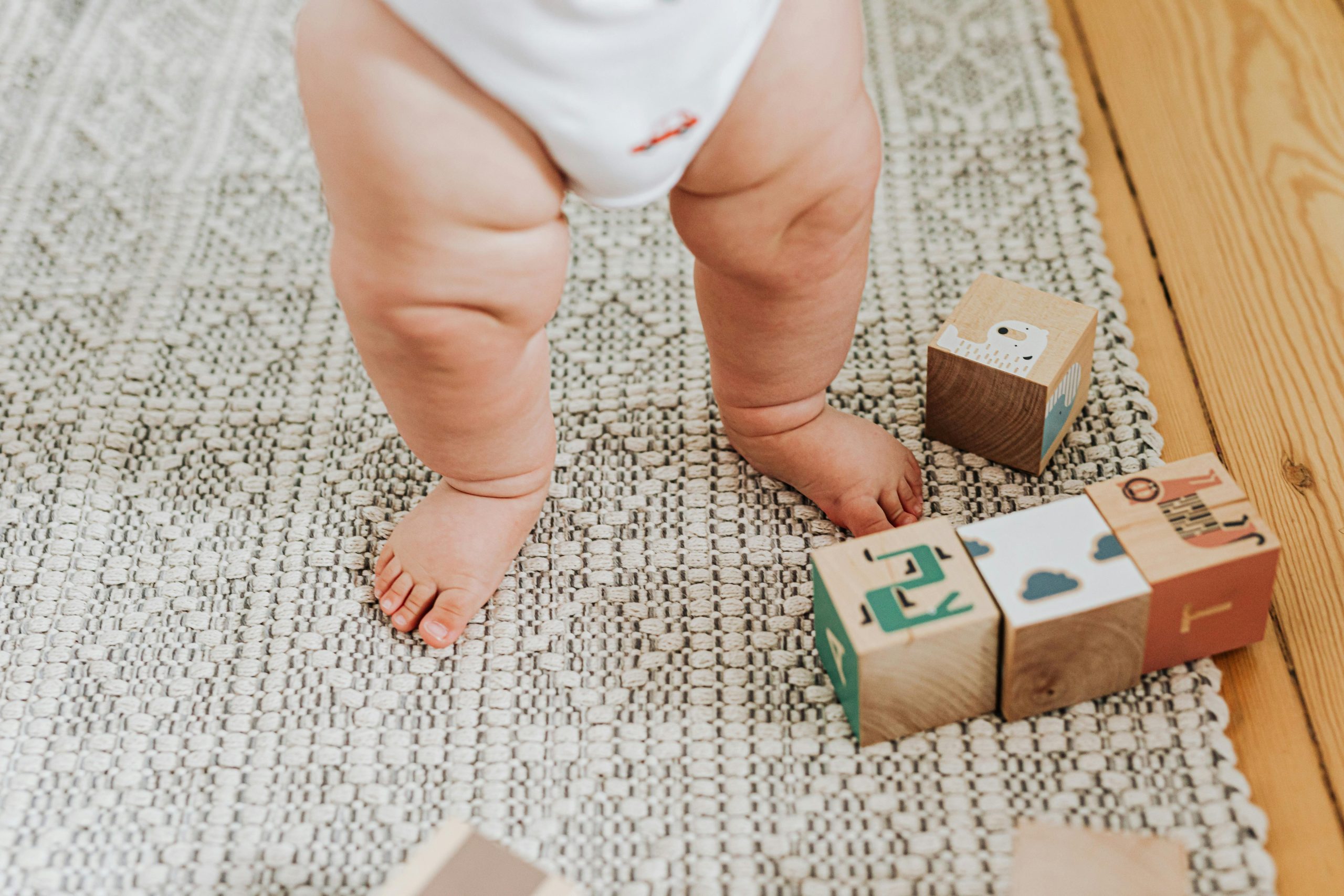 Babies go through important developmental milestones in their early years. Their brains are constantly growing, and each milestone helps them build the skills they need to thrive. Supporting your baby’s development through play, talking, and exploring the world around them is key.
Babies go through important developmental milestones in their early years. Their brains are constantly growing, and each milestone helps them build the skills they need to thrive. Supporting your baby’s development through play, talking, and exploring the world around them is key.
Developmental Milestones including motor skills, cognitive skills, language, communication, and sensory development are constantly occurring. Learn what to expect each week and how to help your baby reach each milestone. Monitoring these milestones allows caregivers to identify potential delays and seek early interventions if necessary.
Click Below Stem Starts Now Milestone Resource
CDC Developmental Milestone Checklist
*Simple activities like tummy time, playing with toys, and interacting with others help babies develop their skills. It’s important to celebrate each milestone. Every step, big or small, is a sign of your baby’s progress!
Chronological Age vs. Gestational Age for Pre-Term Babies: Children who were born prematurely might meet their developmental milestones later. When looking at development, use an adjusted age for a child who was a premature infant.
- For premature babies, tracking milestones using chronological age (actual age since birth) vs. gestational age (adjusted age based on due date) is crucial for accurate developmental assessment.
- To get your child’s corrected age, begin counting their age from their actual due date, rather than their birth date.

-
-
- Example: A “full term” gestational period is about 40 weeks. A baby born 8 weeks early has a gestational age of 32 weeks. For a baby born at 32 weeks gestational age who is now 16 weeks (four months) old chronologically is 8 weeks (2 months) old corrected.
- 40 weeks expected term gestation – 8 weeks = 32 weeks gestational age.
- 16 weeks since birth – 8 weeks early = 8 weeks (2 months) corrected age
- Example: A “full term” gestational period is about 40 weeks. A baby born 8 weeks early has a gestational age of 32 weeks. For a baby born at 32 weeks gestational age who is now 16 weeks (four months) old chronologically is 8 weeks (2 months) old corrected.
-
* In this case, even if your baby is 4 months old, you should expect them to have the developmental skills of a 2-month-old term baby. So, while you may think your baby is delayed for a 4-month-old, in fact, they are on target for a baby with a corrected age of 2 months.
Click Below Stem Starts Now Newborn Reflex Resource
Increase your baby’s Development and Emotional Security
- Hold your baby face to face.
- Talk in a soothing tone and let your baby hear your affectionate and friendly voice.
- Sing to your baby.
- Walk with your baby in a sling, carrier, or a stroller.
- Swaddle your baby in a soft blanket to help him or her feel secure and prevent startling by the baby’s own movements.
- Rock your baby in a rhythmic, gentle motion.
- Respond quickly to your baby’s cries.
Parent Education Resource
Tracking your baby’s growth and milestones regularly helps ensure they are developing on track and allows you to celebrate every precious moment along the way. Check out the STEM Starts Now growth tracker!
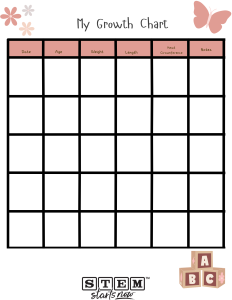

Establishing a newborn schedule helps create a sense of routine, promoting better sleep, feeding habits, and overall comfort for both baby and parents. Check out the STEM Starts Now newborn schedule!

Early Intervention Process
Is the term used to describe the services and support that are available to babies and young children with developmental delays and disabilities and their families. May include occupational therapy, speech therapy, physical therapy, and other types of services based on the needs of the child and family. These services can have a significant impact on a child’s ability to learn new skills and overcome challenges and can increase their success in school and life.
- Early intervention focuses on helping eligible babies and toddlers learn the basic and brand-new skills that typically develop during the first three years of life, such as:
- physical (reaching, rolling, crawling, and walking);
- cognitive (thinking, learning, solving problems);
- communication (talking, listening, understanding);
- social/emotional (playing, feeling secure and happy); and
- self-help (eating, dressing).
- Programs are available in every state and territory. These publicly funded programs provide services for free or at reduced cost for any child who is eligible.
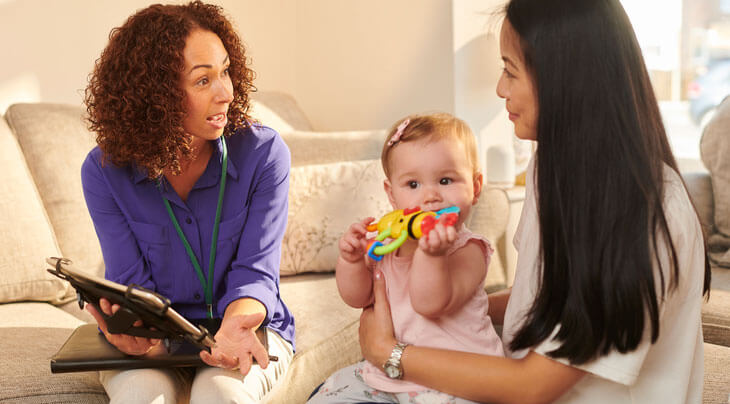
Concerned About Your Child’s Development? Here are some Tips
- Talk to your Child’s Doctor
- If your child is not meeting the milestones for his or her age, or if you think there could be a problem with the way your child plays, learns, speaks, acts, and moves, talk to your child’s doctor and share your concerns.
- Complete a Milestone Checklist for Your Child’s Age
- Use the milestone checklist to track your child’s development. Share the completed checklist or milestone summary with your child’s healthcare provider.
- Ask About Developmental Screening
- Children be screened for general development using standardized, validated tools at 9, 18, or 30 months and for autism at 18 and 24 months or whenever a parent or provider has a concern.
- Easterseals FREE Ages & Stages Questionnaires®, Third Edition developmental screening tool
- Ask For a Referral
- Ask the doctor for a referral to a specialist (ex. Developmental Pediatrician, Child Neurologist, Child Psychologist or Psychiatrist, etc.) who can do a more in-depth evaluation of your child.
- Get an Evaluation
- Call your state’s public early childhood system to request a free evaluation to find out if your child qualifies for intervention services. *Do not need to wait for a doctor’s referral or a medical diagnosis to make this call.
- What to say: “I am concerned about my child’s development and would like to request an evaluation to find out if he/she is eligible for early intervention services.”. Can you help me or let me speak with someone who can?”
References:
Centers for Disease Control and Prevention. (n.d.). Developmental milestone checklists. https://www.cdc.gov/wic-guide/media/pdfs/FULL-LIST-CDC_LTSAE-Checklists2021_Eng_FNL2_508.pdf
Centers for Disease Control and Prevention. (2023-a). What is “early intervention”? https://www.cdc.gov/ncbddd/actearly/parents/states.html#textlinks
Centers for Disease Control and Prevention. (2023-b). Concerned about your child’s development? https://www.cdc.gov/ncbddd/actearly/concerned.html/#childthree
Center for Parent Information and Resources. (2021). Overview of early intervention. https://www.parentcenterhub.org/ei-overview/
Johns Hopkins Medicine. (2024). The growing child: Newborn. https://www.hopkinsmedicine.org/health/wellness-and-prevention/the-growing-child-newborn
Healthy Children. (2018). Corrected age for preemies. https://www.healthychildren.org/English/ages-stages/baby/preemie/Pages/Corrected-Age-For-Preemies.aspx
NICHD Neonatal Research Network. (n.d.). NICHD neonatal research network web-based adjusted age calculator. https://neonatal.rti.org/index.cfm?fuseaction=adjustedagecalculator.main

